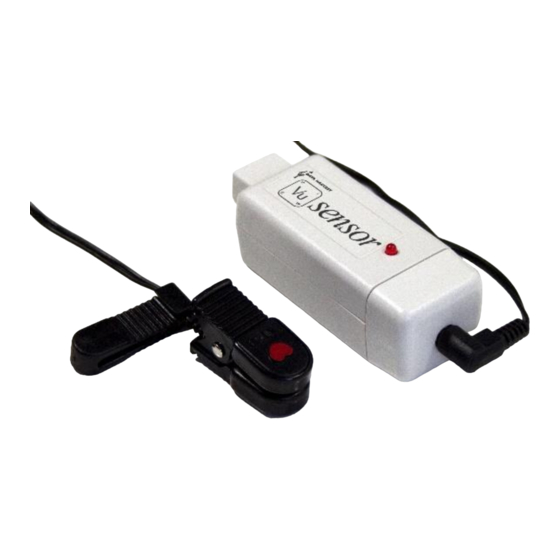Data Harvest 2327 빠른 시작 매뉴얼 - 페이지 4
{카테고리_이름} Data Harvest 2327에 대한 빠른 시작 매뉴얼을 온라인으로 검색하거나 PDF를 다운로드하세요. Data Harvest 2327 6 페이지. Vu heart rate sensor

Background
The Heart rate sensor is used to measure the pulse that is found throughout the human body.
This pulse will result in a change in the volume of arterial blood with each pulse beat. This
change in blood volume can be detected in the fingertip or ear lobe using a technique called
Photoplethysmography. The device that detects the signal is called a plethysmograph (or 'pleth'
for short).
The pleth consists of:
An infrared LED which illuminates the tissue and
A light sensitive detector (LSD), which detects the amount of light transmitted from the
tissue.
The infrared LED and the light sensitive detector (LSD) are mounted in a spring-loaded
device that can be clipped onto the fingertip or ear lobe.
Finger Vascular Bed
Infrared light is absorbed well in blood and weakly in tissue. Any changes in blood volume will
be registered since increasing (or decreasing) volume will cause more or less light absorption.
Heart rate (beats per minute)
Heart rate is a direct measure of how many times your heart contracts to pump blood to your
body in a minute. A child has a smaller heart and therefore their heart needs to beat faster in
order to pump the proper amount of blood.
Heart rate can vary with age as shown below:
Age
Newborn
7 years
14 years
Adult
In normal healthy individuals the heart rate, and thus the pulse rate, varies with the body's
need to absorb oxygen and excrete carbon dioxide. When you exercise or feel anxious your
heart beats more quickly, increasing the flow of oxygenated blood to your muscles. It may
also be increased by stress, adrenaline entering the bloodstream or with an increase in
temperature caused by fever. The heart rate decreases when asleep and some medical
conditions may also cause a drop. Irregular changes in heart rate occur in all people.
Following exercise it takes a while for the heart rate to return to resting level. This is the
recovery time and gives an indication of the fitness of the individual. Recovery time may vary
from less than five minute in very fit individuals to around 15 minutes.
Safe Pulse rates
During experiments the safe heart rate should not be exceeded. The safe level is given as the
maximum heart rate for age, minus 20 beats per minute.
Age
7 & 8
9 & 10
11
12 & 13
Infrared LED
Light Sensitive Detector
Average heart rate (beats per minute)
Maximum heart rate
210 – (0.65 x age)
205
204
203
202
140
85 – 90
80 – 85
70 – 80
Safe heart rate
Max. heart rate - 20
185
184
183
182
